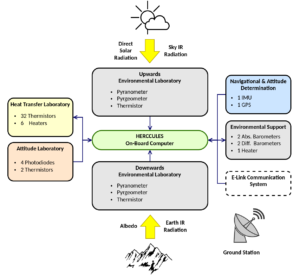he REXUS/BEXUS programme allows students from universities and higher education colleges across Europe to carry out scientific and technological experiments on stratospheric research balloons and rockets. The REXUS/BEXUS programme is realised under a bilateral Agency Agreement between the German Aerospace Center (DLR) and the Swedish National Space Agency (SNSA). The Swedish share of the payload has been made available to students from other European countries through a collaboration with the European Space Agency (ESA).
ESA has selected the UPM experiment proposal for the BEXUS programme. HERCCULES (Heat-transfer and Environment Radiative and Convective Characterization in a University Laboratory for Experimentation in the Stratosphere) aims to characterize the
convictive heat transfer in the stratosphere, as well as the balloon dynamics during the ascent and float phases.
However, the BEXUS programme has suffered delay (the balloon was planned to be launched from Sweden on October 2022). In the meantime, a prototype experiment called TASEC-LAB (Thermal Analysis Support and Environment Characterization Laboratory) was developed and successfully launched on 16th July, 2021 from the León airfield, Spain.
HERCCULES is the experiment to be launched in a stratospheric balloon from BEXUS.
Students of the Space Systems master’s degree (MUSE) at UPM develop the experiments with the supervision of professors from IDR (Instituto Universitario de Microgravedad Ignacio da Riva) and the STRAST resarch group.
Both projects have a limited cost budget and short development period. As a result, we decided to base the design using COTS components and the structure follows the CubeSat philosophy. STRAST is in charge of the OBC (On-Board Computer) selection and the OBSW (On-Board Software) implementation. The OBC is a Raspberry Pi Model 4B. In the case of TASEC-Lab, the electronics are chosen among compatible modules and assembled on the OBC through a prototype HAT (Hardware Attached on Top), resulting in a robust and affordable design. HERCCULES is a more elaborate experiment, which is why UPM electronic engineering students designed and manufactured PCBs that serve the same purpose as the HATs.
The OBC communicates with three experiment in TASEC-LAB and five in HERCCULES. These experiments are equiped with devices such as heaters, anemometers, pressure and temperature sensors, photodiodes, IMU, pyranometers and pyrgeometers.
The on-board software follows a layered architecture: bus handlers, equipment handler, data pool and application layers. Those layers use the services provided by the operating system (Debian Buster distribution) and the required device drivers. The application layer is in charge of the system’s experiments and was implemented with TASTE (The Assert Set of Tools for Engineering), a toolchain developed and maintained by ESA that follows the model-based and component-based development paradigms.

